Annual Currency Outlook
2025 Currency outlook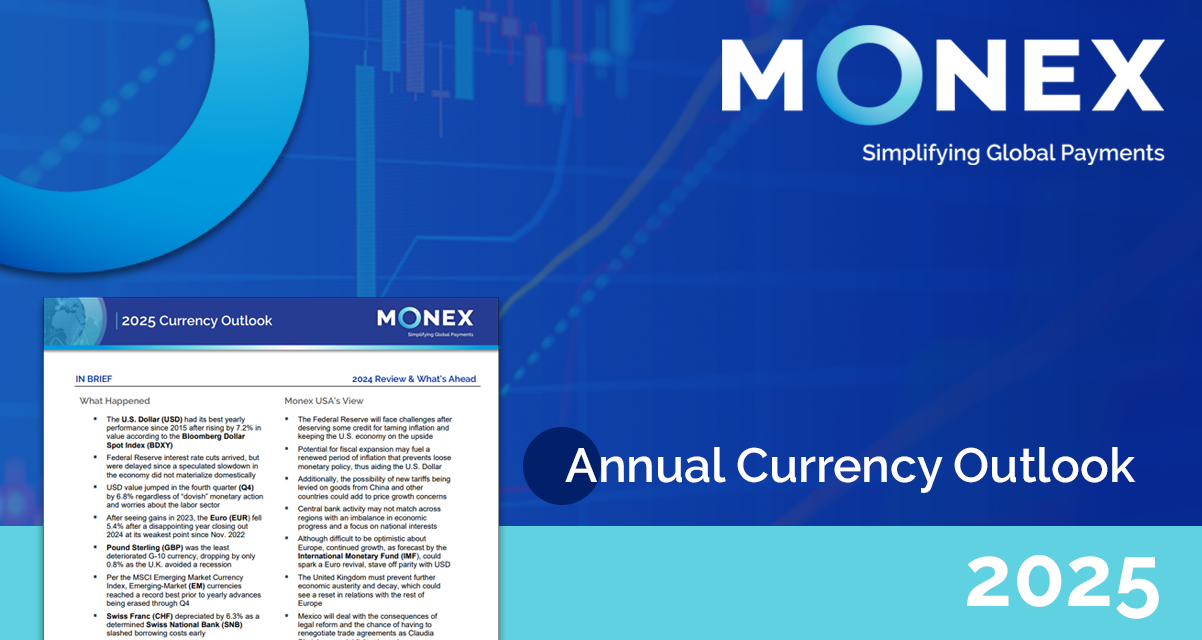
Download full report
What Happened
- The U.S Dollar (USD) had its best yearly performance since 2015 after rising by 7.2% in value according to the Bloomberg Dollar Spot Index (BDXY)
- Federal Reserve interest rate cuts arrived, but were delayed since a speculated slowdown in the economy did not materialize domestically
- USD value jumped in the fourth quarter (Q4) by 6.8% regardless of “dovish” monetary action and worries about the labor sector
- After seeing gains in 2023, the Euro (EUR) fell 5.4% after a disappointing year closing out 2024 at its weakest point since Nov. 2022
- Pound Sterling (GBP) was the least deteriorated G-10 currency, dropping by only 0.8% as the U.K. avoided a recession
- Per the MSCI Emerging Market Currency Index, Emerging-Market (EM) currencies reached a record best prior to yearly advances being erased through Q4
- Swiss Franc (CHF) depreciated by 6.3% as a determined Swiss National Bank (SNB) slashed borrowing costs early
- Mexican Peso (MXN) dropped by 18.3%, its worst annual collapse since 2008 after a mix of political anxiety and concerns over trade
- The Japanese Yen (JPY) had its weakest year since 2013 with a 9.7% decline as political turmoil overshadowed the Bank of Japan’s (BOJ) start of a tightening cycle
- Canada’s weakened Gross Domestic Product (GDP) in the second half of the year helped the “Loonie” (CAD) dive to its weakest levels since March 2020
- Equities saw new all-time highs, but with market concentration as few large firms in tech accounted for most of the expansion
Monex USA’s View
- The Federal Reserve will face challenges after deserving some credit for taming inflation and keeping the U.S. economy on the upside
- Potential for fiscal expansion may fuel a renewed period of inflation that prevents loose monetary policy, thus aiding the U.S. Dollar
- Additionally, the possibility of new tariffs being levied on goods from China and other countries could add to price growth concerns
- Central bank activity may not match across regions with an imbalance in economic progress and a focus on national interests
- Although difficult to be optimistic about Europe, continued growth, as forecast by the International Monetary Fund (IMF), could spark a Euro revival, stave off parity with USD
- The United Kingdom must prevent further economic austerity and decay, which could see a reset in relations with the rest of Europe
- Mexico will deal with the consequences of legal reform and the chance of having to renegotiate trade agreements as Claudia Sheinbaum establishes her reign
- Canada will have a campaign year likely to feature more turbulence for “Loonie” before it experiences any strengthening
- BOJ and Prime Minister Shigeru Ishiba will keep us on edge of our seats about another round of FX intervention or rate hikes
IN FOCUS
BBDXY: 2024 ended with a rally for the Dollar fueling multi-year highs
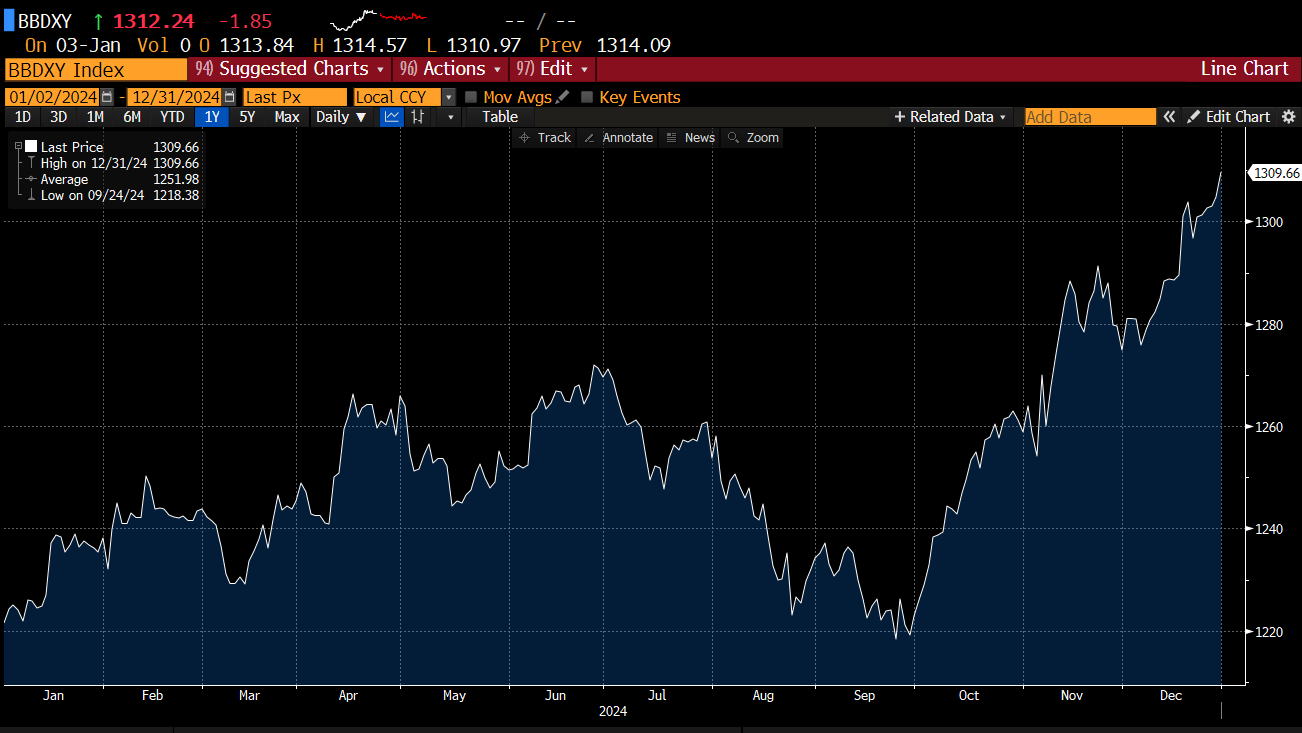
(Bloomberg Dollar Spot Index had its best upward swing in nine years)
USD got a boost from economic indicators that delayed Fed loosening
- As seen on the graph, USD sky-rocketed in Q4 with a 4.4% rise since the Nov. 5th elections
- After naturally dipping in anticipation of a 50 basis-points rate reduction in September, the Buck rose because the Fed chose to proceed with only 25-bps in meetings that followed
- Fed Chairman Jerome Powell highlighted that the economy never truly cooled off regardless of restrictive policies, but inflation steadied
- Troubles elsewhere in attempting to foment growth made it possible for the U.S. Dollar to be a safe-haven asset in midst of chaos
THE VIEW – Buck dominance may continue if global growth declines
Possibility of changes to global trade dynamics could derail the post-pandemic recovery
An eventful 2024 represented a year of major change after half of the globe’s population had scheduled, as well as unscheduled, elections. Almost five years after the pandemic’s shock that caused major shutdowns to economic activity because of the health crisis, plenty of the world’s constituents made it clear that they want leadership changes in order to bring upon plans that improve their socioeconomic condition.
Indeed, four billion people across 70 countries went to vote last year and, in every region, plenty of incumbents lost their seats. As a result, new coalitions had to be formed and are still forming in order to legislate and govern. Parties that held power for years, some over a decade, experienced unforeseen defeats.
Although global growth, excluding the United States, actually saw a bit of a bump from 2023 to 2024 by improving from an annual GDP pace of 2.9% to 3.1%, workers around the world called for strikes or at least negotiations for higher compensation. While many central banks agreed with the Fed and took on a tightening cycle for a year or more to combat inflation, their efforts did not curb prices as had been hoped. Consequently, the affordability of basic staples and Durable Goods Orders took a hit while higher interest rates prevented overcoming economic sluggishness.
Excluding the United States, inflation increased by 5.8% worldwide. Energy costs were one of the main culprits as the ongoing war between Russia and Ukraine has been met with more sanctions that have disrupted the flow of natural gas and other traditional fuels. Armed conflict also affected ports and routes in the Middle East while growing tensions between China and Taiwan caused delays around the Pacific Rim.
With such turbulence taking place, it was easy for the U.S. Dollar to climb like it did, as economic divergence made it clear that America’s recovery from the post-COVID era has been met with a “no-landing” scenario despite high borrowing costs. Elsewhere, “stagflation” is preventing success.
The situation in the U.S. has been characterized by ongoing improvement to its GDP, which was something that we did not forecast last year. We pointed at various items of the economy that looked to be floundering at the time such as employment and investment in the Services sector, but ultimately the doom-&-gloom never arrived.
Instead, GDP witnessed betterment quarter after quarter. Q1 came in at 1.4%, which served temporarily as a sign that 2024 was going to be a year of struggle in contrast to 2023. However, in Q2, output doubled to 2.8% while in the third quarter it saw a higher figure at 3.1%. Meanwhile, the Services Purchasing Managers Index that had us preoccupied when assessing what would occur, ended up having its best outcome since April 2022.
Acknowledging that the economy kept upward momentum, Fed Chairman Jerome Powell and other officials considered it appropriate to hold back on the cutting of interest rates until the end of September. After a 50-bps reduction, the Fed never committed to another move like it and members have even stated their hesitation in conducting themselves in a “dovish” manner, mostly out of fear that the economy will keep advancing and prices will remain stubborn.
Along with the Fed, some economists are wondering if inflation can be contained if 2025 turns out to be a year of higher costs to trade in the form of new tariffs. The incoming Trump administration has vowed to exercise a more protectionist framework in order to increase the manufacturing of products domestically and compete more aggressively in technologies as well as innovation. China has been a focal point, but also neighboring countries like Mexico may not be spared.
As there are no specific courses of action yet, but just statements from the elected President about levying tariffs as high as 60.0% on Chinese goods and 25.0% on imports from our North American trade-pact partners, here are some possible pieces of legal footing that could be exercised in the upcoming months. One is getting rid of the “De Minimis” threshold, which allows goods valued under $800.00 to enter duty-free. That would mean any good regardless of its value would face a tax.
There are also sections within the Harmonized Tariff Schedule (HTS) that could be triggered for adding tariffs and circumvent congressional approval. An example would be Sec. 232 which stipulates that the President may introduce tariffs on items considered a threat to national security. Additionally, the U.S. can impose Countervailing Duties (CVDs), which are specifically targeted at imports that have been subsidized by foreign governments.
It is worthy to wonder if trading alliances such as the BRICS group (including more countries than just Brazil, Russia, China, and South Africa) will be a more united front that has the ability to counter barriers from the U.S. Collectively, BRICS represents 40.0% of the total globe’s population while accounting for 74.0% of the world’s aluminum production as well as 54.0% of rice harvest.
We also ponder if we are entering a period of major negotiations over everything from the USMCA (NAFTA 2.0) trade agreement to accords for alleviating dollar strengthening like seen in the 1980s. In 1985, the Plaza Accord took place with the goal of deflating the Buck against the Japanese Yen and European tender as well as addressing a trade deficit out of control. Will these types of talks happen as some American leaders and others seem eager to abandon a globalized agenda?
During the first Trump term as President between 2017 and 2021, the Buck dipped in value by 13.0%. While it is not clear if he is going to pursue strong-dollar or negative-dollar policies, that drop was met with a 17.0% appreciation between 2021 and 2024 in his absence. There is a wildcard element to the White House as they seek to test the limits of executive-branch power in financial influence, which will surely be met with retaliation.
China is likely going to lose its Most-Favored-Nation status that gives certain trade advantages to countries deemed allies. Aside from that, the dollar will certainly be impacted by the possible end to militarized warfare and nations looking to be part of “Friend-shoring” as there is a realignment between countries based on mutual interests, values, and goals.
EUR – Turbulent times have taken a toll on the shared currency. Will they last?
Lack of confidence in the shared currency with stagnation and discord in the EU’s legislative chambers
Turmoil in the Euro-zone has some economists contemplating the chances that Europe becomes more fragmented and less integrated. While we see no chance for a break-up, 2024 was a year in which member states had to cope with the rise of nationalism and division among lawmakers across the Ancient Continent. The negative effects of ongoing conflict between Ukraine and Russia started to show, affecting the larger EU economies.
Germany has been, without a doubt, a worrisome case as the reliability on fossil fuels from Russia truly hurt its ability to overcome the lingering negativity from pandemic-related shutdowns once the war began on February 2022.Now as that interdependence is not something to rely on, the Germans deal with much higher energy costs, productivity costs, and recessionary pressures.
Truly, they have managed to survive dipping into contractionary territory with only GDP jumps as high as 0.2% per quarter. The German economy is now 5.0% smaller than if it had been able to return to pre-pandemic growth levels, but the mix of imbalance between states and war nearby got in the way.
In September, Volkswagen made the announcement that it would consider completely closing down some factories in Germany, a first in the leading automaker’s history. Furthermore, an analysis of measures and actions taken in the Euro-zone to fight off the headwinds brought by COVID-19 concluded that not enough was done to avoid the big drop in productivity.
The reality is that a lot of countries decided to take the emergency into their own hands and that led to inconsistent programs and economic letdowns.
If the Euro-zone had taken on comprehensive structural reforms to handle the damage and worked towards a more cohesive recovery, it is estimated that the single-market economy would count on an extra €3.0 trillion a year. Measures to have eased labor-market flexibility, encouraged innovation, and fostered a re-energized business environment were not wholly implemented.
Olaf Scholz and Emmanuel Macron, the respective leaders of Germany and France are currently fighting for their political lives with intense dissatisfaction that has led to snap elections and votes over confidence. This also comes at a time when EU superiors are putting together efforts to decouple from China as fears have grown regarding personal data security, with cybersecurity now a priority.
Regardless of how bad things may seem across the Atlantic, we do not think the shared currency will plummet in 2025 and go towards parity with the dollar. Unison may not describe current dynamics, but other countries are applying and joining as members. Bulgaria and Romania are slated to officially be transacting in Euros starting this year.
According to the International Monetary Fund, there are reasons to stay positive about the Euro-zone’s potential, mentioning in their outlook how there is steady growth and moderated inflation. Euro-zone annual GDP advanced throughout 2024 with the final reading of Q3 at 0.9%, an improvement from Q2’s 0.6% and Q1’s 0.4%. Perhaps there is light to be seen down the tunnel.
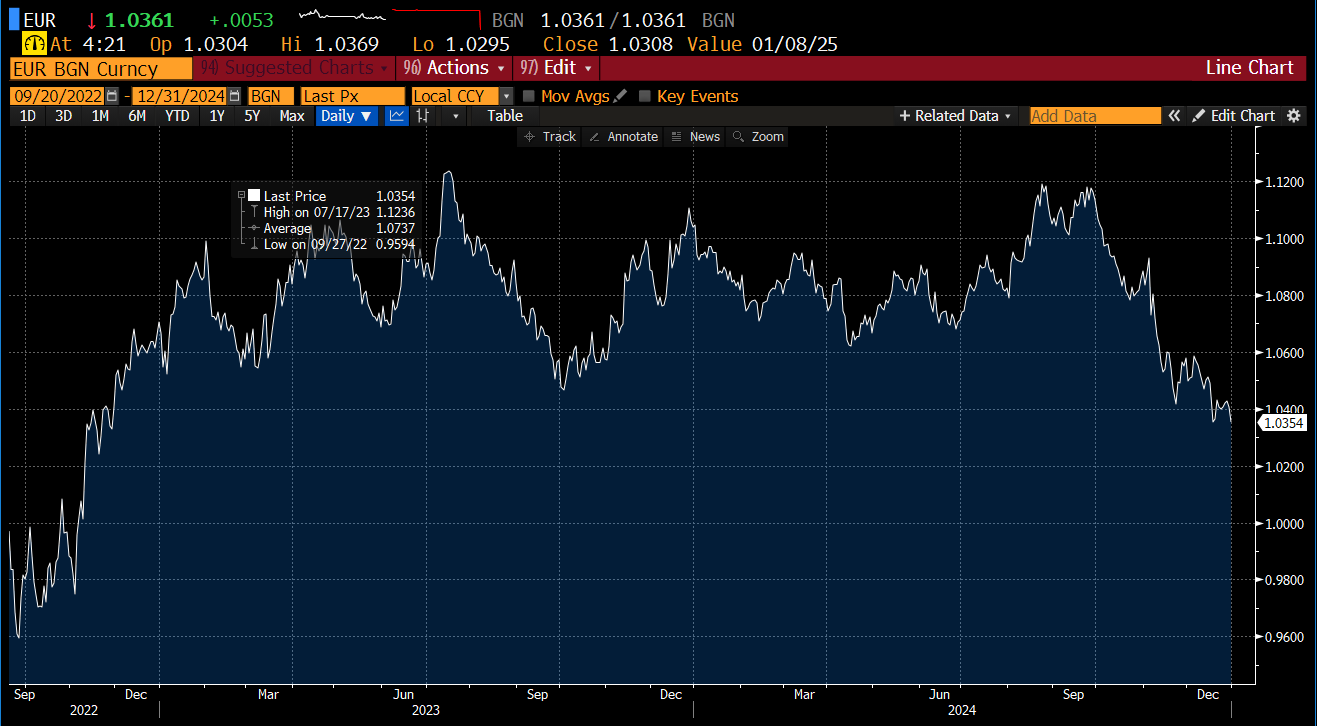
(Bloomberg graph shows how the Euro fell to its weakest point in two years Nov. 2022-present)
GBP – “Hawkish” Bank of England kept GBP as the least depreciated of the majors
Surprises in economic releases helped the U.K. to avoid dropping into a recession
Sterling did not even lose one percent of its value against the Buck as the narrative for the United Kingdom seemed to become less pessimistic than originally thought. Coming into 2024 with an average yearly GDP of (-0.2%) in Q4 2023, the data suggested that worse times could be ahead.
On the contrary, the British economy found its footing and began to gradually expand as Q1 came in at 0.7%. During the first half of the year, former Prime Minister Rishi Sunak was credited for navigating through difficulties yet achieving some denting to inflation. The relief has not been consistent, but at least food costs did come down from their multi-decade highs.
It is this strange state of “stagflation,” that has convinced the majority of officials in the Bank of England to be wary of committing to interest rate cuts. On the one hand, robust lowering of borrowing expenses could aid an economy desperate for quicker expansion, but with prices for everything still at uncomfortable levels, BOE members do not want to further boost inflationary advancement. There has not been consensus.
In August, markets welcomed a change of the guard after U.K. elections produced a new Prime Minister in Keir Starmer from the Labour Party. It was the first time in 14 years that the Tories, the Conservative Party, lost their majority in Parliament. Subsequently, the Pound flourished in September and hit its highest value over the dollar since March 2022.
Enthusiasm had been building behind the plan to increase public spending via an ambitious budget, but it has mostly faded. As good as it was to see a rebound economically in the first half of the year, the story has become less rosy after September.
Furthermore, lawmakers were hoping to expand fiscal stimulus along with reductions to borrowing costs from the BOE, but the central bankers have only reduced their benchmark interest rate by 50 basis points unlike their European, Swiss, and American counterparts.
Evidence of the downturn came in the third quarter as the economy registered 0.0% in GDP growth. A closer look at monthly progress revealed GDP contracted (-0.1%) consecutively for two months between September and October. Starmer’s administration certainly has a lot of work ahead of them to shift it all around.
Thus far, the government has proposed a few major reforms to revamp various economic sectors. While looking to adjust taxes to make the financial environment friendlier and U.K. more competitive in attracting investment, officials want to see more construction and work towards renewable energies. As many as 1.5 million homes could be built in the next 5 years to resolve the Housing shortages of current day and wind farms will be erected to lower costs and exude cleaner energy.
We can see GBP mixed again throughout 2025 as a desire for changes could be met with friction as public sentiment has turned sour on Labour after elections that appeared to hand them a mandate.
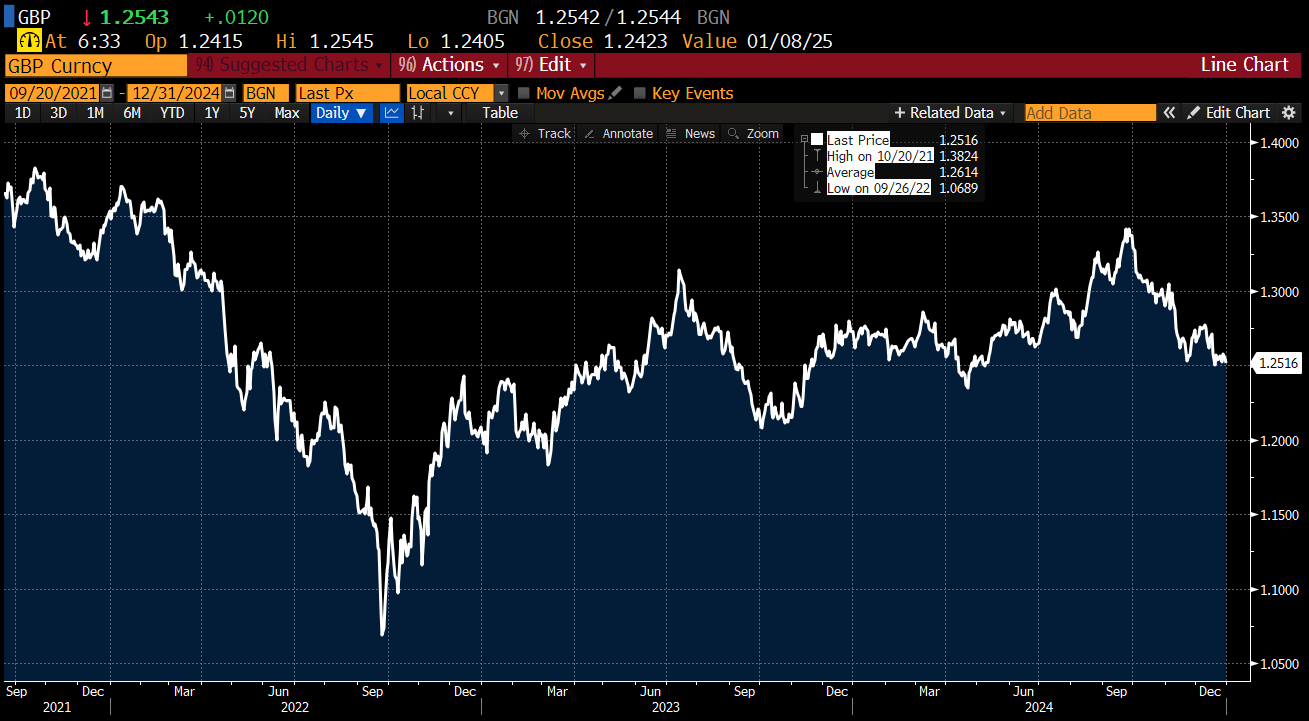
(Bloomberg graph shows GBP climbing to a 2.5-year high then descending in Q4 2024)
JPY – No reward for Yen after getting away from negative interest rates
Bank of Japan’s first hike in 17 years was overshadowed by political havoc and leadership changes
It took until their March meeting, but the Bank of Japan delivered on its promise to increase interest rates and get them above zero percent. Unlike other major central banks, the BOJ had maintained an ultra-loose policy to stimulate lending from banks and combat deflation since January of 2016 when it reduced borrowing costs to (-0.1%).
Japan’s economy has been plagued by deflationary pressures for a long time while keeping a trade account surplus with high demand for its exports, primarily cars. This year marked a major shift for borrowing costs although the economy remains far from being so hot that it requires aggressive contractionary monetary policy.
In fact, the first quarter experienced a drop of half a percent to quarterly GDP. Thankfully for officials, the second quarter fared much better with an uplift of 0.7% although that was cut by more than half in Q3 registering just 0.3% growth. Meanwhile, stocks had their best year ever, with the NIKKEI exchange up by 19.0% for 2024.
Nevertheless, the Yen was primarily impacted in the latter part of the year by corruption scandals that forced former Prime Minister Fumio Kishida to announce his resignation. New PM Shigeru Ishiba took his place and immediately seek to concentrate more political power to enact his agenda including the revitalization of rural areas as well as fixing the country’s complex security atmosphere
Shortly after taking the oath, Ishiba dissolved the lower house of parliament in order to have snap elections on October 27th. He hoped it would translate into a strong mandate, but the voting backfired. His ruling coalition between the Liberal Democratic Party (LDP) and Komeito party lost their majority. It is the first time in 12 years since the victory by late PM Shinzo Abe that the LDP lost its dominance in calling the shots.
We see Yen chances for appreciation up in the air as BOJ members and other financial authorities claim to be ready to intervene in the FX market but have backed off on multiple occasions. BOJ Governor Masayoshi Amamiya has been relatively less confident about sustaining a “hawkish” trend after declaring it worrisome that Japan jumped into political uncertainty. JPY fell 11.8% after touching its highest point since summer 2023 in September.
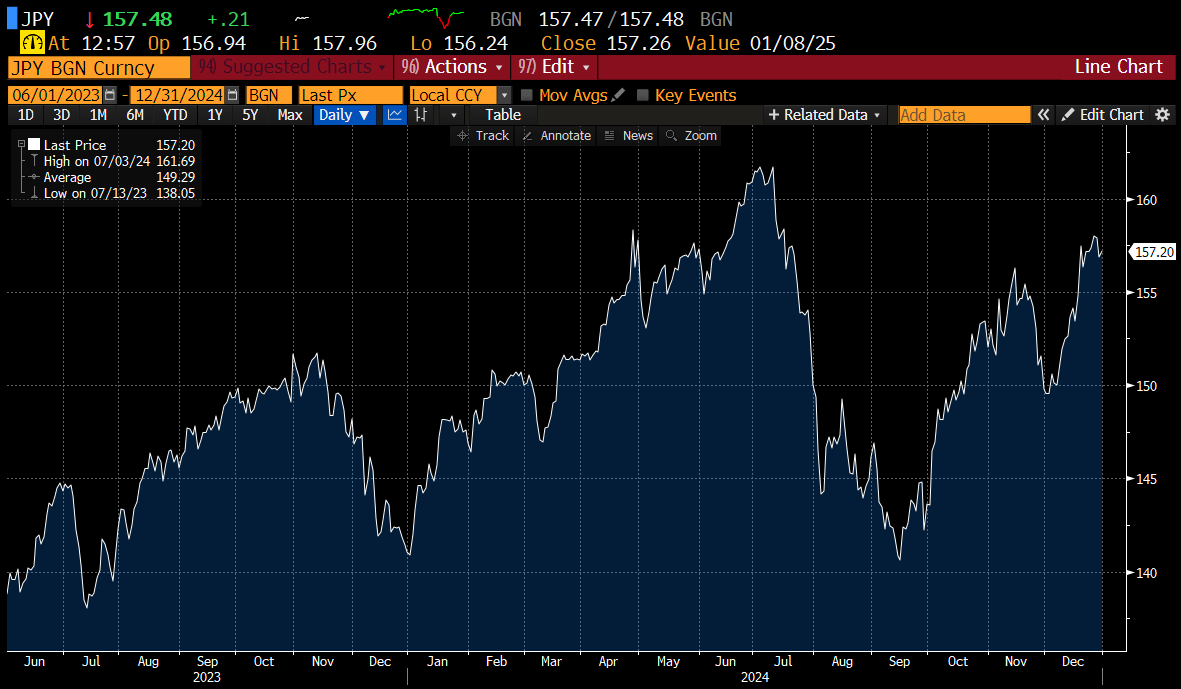
(Bloomberg graph displays JPY’s wild moves in the past two years, no clear guidance)
CAD – Unhappiness in Canada crushed the “Loonie” to a 2020-low
A slowdown in the economy has Canadians frustrated with stagnation as well as their leadership
Since 2022, our neighbors up north have seen a major decline in living standards as efforts by the government to stabilize the country have come up short. Throughout this period, the federal debt has increased significantly while accompanied by a foremost decline in productivity.
According to official data, Canada is going through its most severe drop in living standards in four decades. GDP per capita has continued to dwindle and Canada ranks last with the lowest expansion rate among 50 developed economies since 2019.
Quarterly GDP demonstrated this rapid dive in confidence as Q2 came in at 2.1% but was slashed to a 1.0% pace during Q3. Inflation has moderated some, standing at a yearly average of 1.9%, but consumers are experiencing high costs of living along with friction in wages overall.
At the time of writing, news broke that Prime Minister Justin Trudeau would be resigning as Liberal Party leader and leave the Prime Minister post when a new head is chosen. It is likely he will remain in the office for another few months. Elections scheduled for October will still take place while some candidates are already making their rounds to gain popularity.
Chrystia Freeland, Trudeau’s former Minister of Finance who served from August 2020 until she quit in December, is one of the strongest contenders. A familiar name to us in Mark Carney, the former BOC and BOE governor, is also up for the job after being an advisor on economic and environmental matters.
We thought there was room for CAD to advance in 2024, but we could not foresee the political downfall of Trudeau as a consequence of sluggishness. 2025 could have a different spark under new direction. CAD jumped following the announcement.
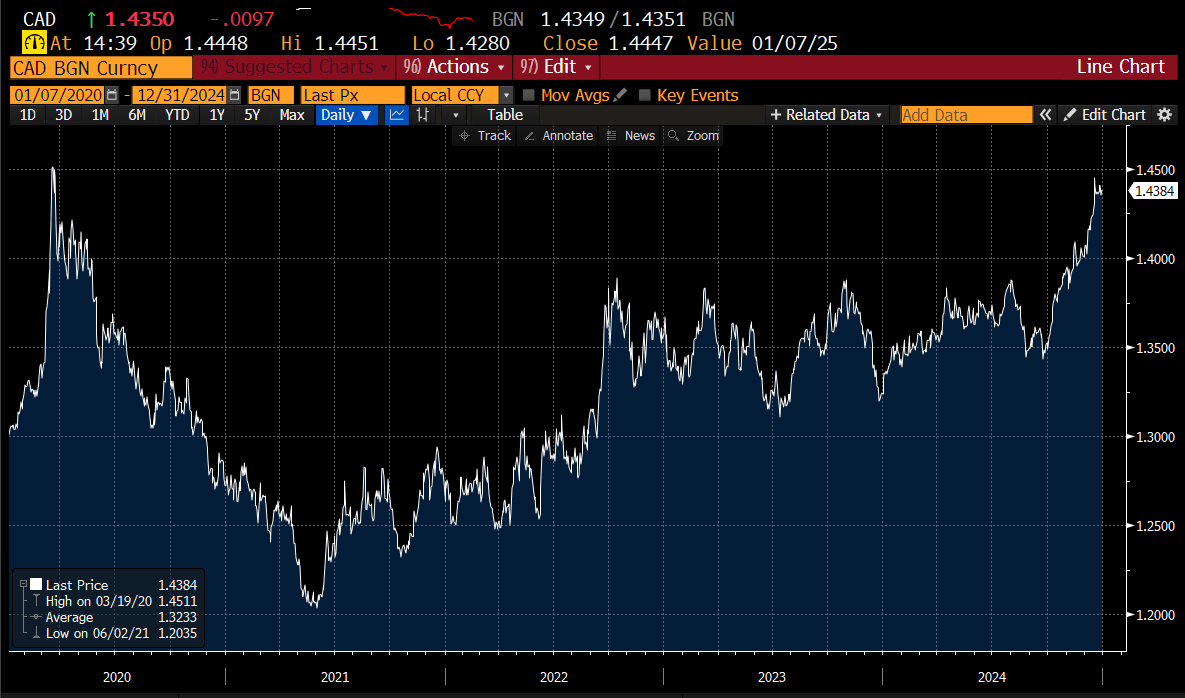
(Bloomberg graph shows the big drop in CAD value in the past two years, back to 2020-worst levels)
MXN – Anxious markets punished the Peso with fears over drastic change
LATAM currencies followed MXN’s trajectory from beacons of strength in 2023 to multi-year lows through 2024
Only the first quarter of the year played out as we imagined with the Mexican Peso rising based on economic resilience and even reaching its highest level over the Buck since 2015. Unfortunately, the 4.3% appreciation streak seen in the initial four months of 2024 was beyond erased for the remainder.
Confidence seemed to be portrayed at the beginning with the country’s central bank, Banxico, pausing interest-rate cuts in March citing the economy and tamed inflation. Previous gains for MXN were due to the positive effects emanating from “Nearshoring,” which meant Mexico became the #1 trading partner for the U.S. surpassing China.
As belief in the global economy floundered through the middle of the year, countries started to act more stimulus-driven, which turned Banxico members “dovish” as they reignited interest-rate reductions in August. No matter how conducive towards easing the financial environment, the reductions in interest did nothing to prevent the domestic stock exchange, MEXBOL Index, from a 14.0% nosedive. Its worst performance since 2008.
In June, presidential elections gave us a clear winner in Claudia Sheinbaum, a former mayor of Mexico City just like AMLO, who is looking to establish his legacy and that of the Morena Party. MXN started declining quickly following the results, which gave Claudia a super majority in Congress to pursue any goals she desired. Markets found issue with the idea of a one-party system developing without much opposition to even review proposed legislation.
Furthermore, AMLO was setting the ground during a transition period before she officially held office as President on October 1st to gain enough support to pass constitutional reforms. The Morena Party finds it ideal to elevate certain social programs from legislative to constitutional status in order to guarantee their continuity.
Additionally, Sheinbaum wants judicial reforms and for judges to face appointment by the public’s vote. Traders and investors do not want the possibility of Mexico’s institutions losing their autonomy as the president aims to extend the powers of the executive branch and have oversight of the National Election Council or more worrisome, Banxico.
MXN closed out 2024 trading at its weakest value against the dollar since March 2022. Mexico’s economy has lost the momentum depicted after being one of the better off countries following the pandemic re-opening epoch. 2023’s annual growth of 2.5% could not be sustained as 2024 finished at 1.6%.
2025 could be full of more surprises than just tariffs, which appear to be of upmost importance with Trump vowing to make changes to USMCA and other parts of the relationship with our southern neighbor. Volatility never evades Peso, thus we see vast up and down swings in what may be a wildcard year. We predict MXN averaging current levels when it is all said and done.
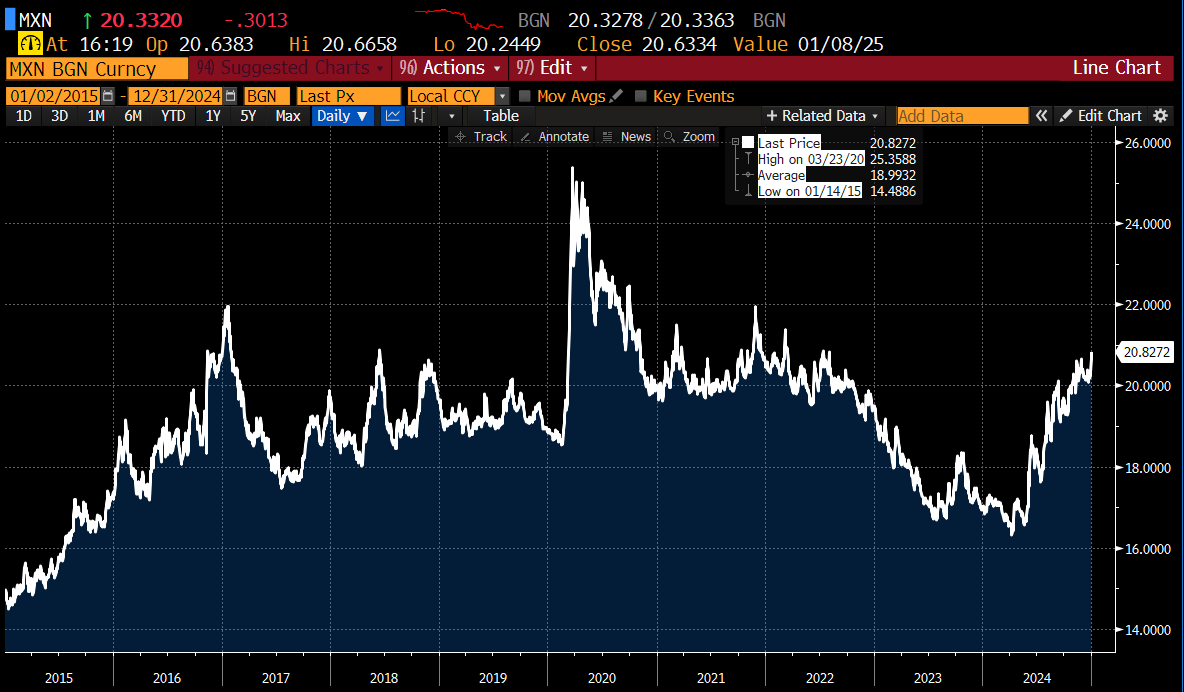
(Bloomberg graph shows how MXN briefly hit its strongest point since 2015 in April 2024)
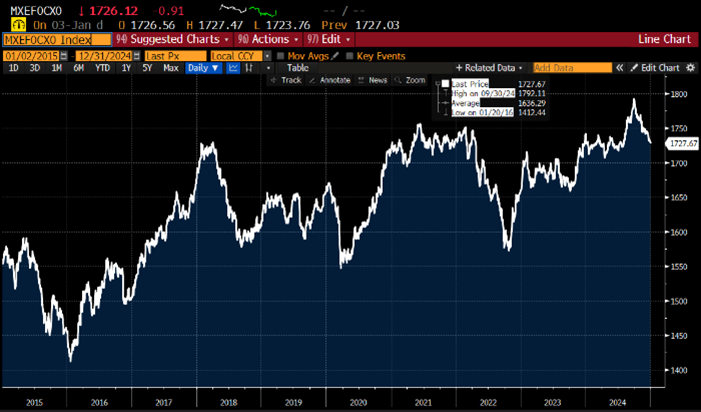
(The MSCI Emerging Markets Currencies Index hit an all-time record after EM economies outdid Developed ones in USD terms)
Ready to optimize your FX with our award-winning trading team?
BOOK AN INTRO MEETING OPEN A FREE ACCOUNT

